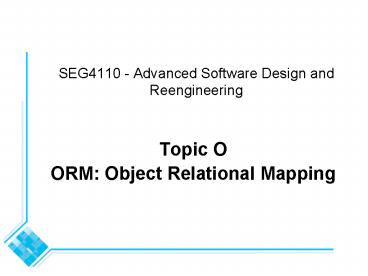SEG4110 Advanced Software Design and Reengineering - PowerPoint PPT Presentation
1 / 13
Title:
SEG4110 Advanced Software Design and Reengineering
Description:
For each object, create a row in both a table for the superclass and a table for ... po-number (foreign-key) A5i. product-source-id (foreign-key) A5i. number ... – PowerPoint PPT presentation
Number of Views:34
Avg rating:3.0/5.0
Title: SEG4110 Advanced Software Design and Reengineering
1
SEG4110 - Advanced Software Design and
Reengineering
- Topic O
- ORM Object Relational Mapping
2
Rules for Mapping an Object Model to a Relational
Database 1
- General Rules
- A. Create one table for each ordinary class
- 1. Make each instance a row in the table
- 2. Make each simple attribute or qualifier into a
column - 3. If a complex attribute is naturally composed
of separate fields, make these into individual
columns - 4. If a complex attribute consumes much space but
is infrequently accessed, store it in a separate
table. - 5. Make 1-1 or many-1 association into either
- i. a column (using a foreign key)
- ii. a separate table with foreign keys indicating
each end of the relation
3
Object-Relational Mapping Rules 2
- General rules cont
- A. cont
- 6. Decide on the key
- The key must uniquely distinguish each row in the
table - i. If unique, one or more of the attributes may
constitute the key - ii. Otherwise, generate a column that will
contain a special object-id as the key
4
Object-Relational Mapping Rules 3
- General rules cont
- B. Create one table for each association that has
many-many multiplicity (and for each association
class) - 1. Make the keys of the tables being related to
be foreign keys in this new table - 2. If we are creating an association class with
additional associations connecting to it, then
create a special object-id as the key - 3. Follow rules A1 to A5
5
Object-Relational Mapping Rules 4
- General rules cont
- C. Deal with inheritance in either of the
following two ways - 1. Keep inherited material in a common table.
- For each object, create a row in both a table for
the superclass and a table for the appropriate
subclass - Relate the two tables using a foreign key in the
subclass table - This is the recommended approach, but has the
following drawbacks - It requires a join to access any object
- It requires inventing an identifier
- 2. Inherited columns can be duplicated in all
subclass tables - There may be no need for a table representing the
superclass - The duplication reduces maintainability
6
Example class diagram for an inventory system
7
Inventory System Tables 1
- Resulting tables Reason
- Product A
- product-code (key) A2, A6i
- description A2
- list-price-per-unit A2
- number-in-inventory A2
- number-to-keep-in-inv A2
- Product-Picture A4
- product-code (foreign-key)
- picture-bitmap
8
Inventory System Tables 2
- Supplier A
- supplier-id (key) A2, A6i
- name A2
- street A3
- city A3
- postal-code A3
- Product-Source B
- product-source-id (key) B2
- product-code (foreign-key) B1
- supplier-id (foreign-key) B1
- suppliers-code-for-product A2
- advertised-cost-per-unit A2
9
Inventory System Tables 3
- Order-To-Supplier A
- po-number (key) A2, A6i
- supplier-id (foreign-key) A5i
- date-ordered A2
- Supplier-Order-Line-Item A
- line-item-id A6ii
- po-number (foreign-key) A5i
- product-source-id (foreign-key) A5i
- number-ordered A2
- date-expected A2
10
Example Class Diagram for Document System - with
Inheritance
11
Document System Tables 1
- Resulting tables Reason
- Document-Component A
- component-key (key) A6ii
- start-pos A2
- end-pos A2
- Compound-Component A
- component-key (foreign-key) C1
- type A2
12
Document System Tables 2
- Primitive-Component A
- component-key (foreign-key) C1
- text A2
- emphasis A2
- Top-Document A
- component-key (foreign-key) C2
- type C2
- name A2
- Part-Relation A5ii
- part-key (foreign-key)
- whole-key (foreign-key)
13
Data modeling vs. OO modeling































